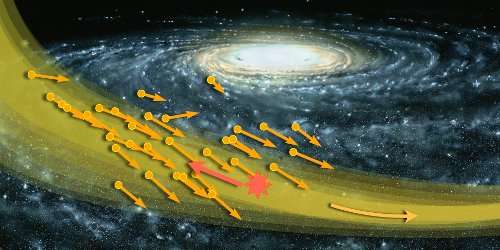According to an international team of astronomers, our solar system is in the path of a “dark matter hurricane” — but there’s no need to panic. The whole event is totally harmless and, what’s more, might actually help scientists finally detect this elusive phenomenon.

Dark matter makes up roughly 27% of the universe, whereas “regular” matter accounts for only 5% — the rest being accounted for by dark energy. despite its ubiquity, nobody knows what dark matter really is or how it works. At the same time, nothing other than dark matter can explain the motion of stars and galaxies, which are expanding more than can be accounted for by regular, visible matter.
Although the evidence for the existence of dark matter is very strong, identifying it has proven extremely challenging — but we may now have a good shot. Researchers from Universidad de Zaragoza, King’s College London and the Institute of Astronomy in the U.K. have been studying a stellar stream left behind by a dwarf spheroidal galaxy that was devoured by the Milky Way aeons ago. The S1 stream, as it was called, was discovered just last year by a team studying data from the Gaia satellite.
Other such streams have been observed before, but this is the first to cross paths with our own solar system. Luckily, none of the 30,000 stars that comprise S1 will collide with us. However, the dark matter that’s moving along with this stream might be picked up by detectors on Earth.
According to several models showing the distribution of the dark matter and its density, the dark matter hurricane is traveling at a staggering 500 km/s. The analysis also allowed the researchers to predict which possible signatures of the stream scientists ought to look for to find dark matter. For instance, the results suggest that WIMP detectors have a slim chance of picking up anything. Weakly interacting massive particles (WIMPs) are hypothetical particles that are thought to constitute dark matter and, by virtue of their weak-scale interaction, WIMPs should be able to be observed by directly detecting their interactions with ordinary matter.
On the other hand, axion detectors may actually have a fighting chance, the authors write in the journal Physical Review D. Axions are hypothetical particles that have a small mass in the milli-electronvolt (eV) range, making them 500 million times lighter than an electron. Additionally, an axion should have no spin. Detectors such as the Axion Dark Matter Experiment might be able to pickup axions from S1 due to possible bumps in the broad spectrum of axions. In the presence of a strong magnetic field, axions should be converted into photons, which we can see, according to a previous estimate.
While there are over 30 such streams known in our galaxy, S1 is the only one to directly interact with our solar system. What’s more, our paths will intersect for millions of more years. So, even if our technology is not advanced enough to detect dark matter particles, there is still plenty of time for more sensitive detectors to be built.


